The Canon EOS 60D is a new prosumer DSLR
camera. Successor to the two year old 50D, the EOS 60D offers a number
of key highlights, including an 18 megapixel CMOS sensor, 3 inch
vari-angle LCD screen, Full HD video capture with manual controls, 5.3
frames per second burst shooting, a 9-point all cross-type autofocus AF
system, DIGIC 4 image processor, Canon’s 63-zone iFCL metering system,
support for SD / SDHC / SDXC cards and an ISO range of 100-12800.
Ease of Use
The Canon EOS 60D is not simply a direct replacement for the 50D with a few extra features. Instead it represents a new category of Canon DSLRs designed to precisely fill the gap between the consumer level EOS 550D / Rebel T2i and the semi-pro EOS 7D. The 60D is almost halfway in size between those two models, and is therefore smaller than the 50D that it replaces, measuring 144.5 x 105.8 x 78.6mm. There's a textured area on both the deep hand-grip and around the thumb-rest on the rear of the 60D, and unlike the smaller and cheaper EOS 550D / Rebel T2i model, this camera is well-suited for everyone with normal to large-sized hands.It's also a little lighter too at 755g (including the battery and memory card) thanks to the adoption of a metal chassis covered with a plastic outer, as also used by the EOS 550D / Rebel T2i. Owners of the 50D may bemoan the abandonment of a magnesium alloy body on the 60D, but we think that the new model is durable enough to survive day-to-day life, especially as Canon claim that the 60D is as weatherproof as its predecessor, and it crucially places less load on your shoulder during the course of a day's shooting.
On more basic SLRs, adjustments are usually made using a combination of buttons and a single control wheel. This is fine for novices, but awkward for experienced photographers who want to be able to adjust a combination of exposure, shutter speed or aperture quickly. Like other semi-pro cameras, the Canon EOS 60D offers two control wheels; a small one on the top of the handgrip, and a large, spinning dial on the back of the camera. This rear quick control dial is characteristic of all high-end Canon EOS cameras. It's a bit of an acquired taste compared to more conventional control dials, but you quickly get used to it and it is easy to spin.
The 50D's small joystick that was used for menu navigation has been replaced on the 60D by a more conventional four-way controller, better suited to upgraders from the more consumer-orientated 550D / Rebel T2i. We grew to like the 50D's joystick, especially as higher-end Canon DSLRs also use it, but we can understand why Canon has implemented a more beginner-friendly four-way controller. Less understandable is the controller's design - sitting slightly proud of the circular dial that surrounds it and looking more like a wheel itself, it takes some time to get used to this less elegant arrangement. The mode dial does feature a lock button which helps to prevent unintentional changes to your settings.
On the 50D, pressing the joystick opened the new Quick Control screen. On the 60D, there's now a dedicated Q button which does the same thing. Depending on which shooting mode you're using, this lets you set various parameters via the LCD screen, using the four-way controller to move around the various options. Similar to the system that Sony Alpha DSLRs have used for a while, the Quick Control screen is particularly well-suited to beginners and tripod work.
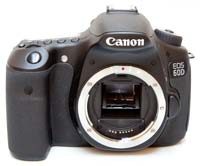 |
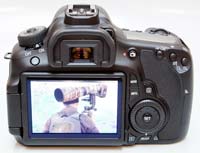 |
| Front | Rear |
The main LCD screen has been significantly improved, now offering a fantastic resolution with 1,040K dots, so you may find yourself using it more often than you thought. Importantly it also brings the EOS 60D in line with its main competitors, and it also allows you to judge the critical sharpness of your photos using the LCD screen, which has been a long-standing issue on Canon's entry- and mid-range DSLRs. The 1,040,000-dot resolution of the rear LCD panel may not sound like a lot more than the 920,000 dots of the 50D's display, but given that the new screen has an aspect ratio of 3:2 - i.e. identical to that of the sensor - the photos now fill the screen completely, with no black stripes along the top and bottom.
More importantly the 60D is the first EOS DSLR to feature an articulated screen. It's taken quite some time for Canon to realise that the full potential of Live View and video shooting can only be exploited if it's delivered on a hinged screen, but the company has finally joined the ranks of Olympus, Panasonic, Sony and most recently Nikon in offering a model sporting this feature. In terms of flexibility, Canon's left-hinged, free-angle monitor is on a par with those offered by Olympus and Panasonic, and significantly more flexible with those found on Sony and Nikon DSLRs. The high-res, free-angle LCD screen is much more than just a novelty - it's a lot more versatile than the usual combination of optical viewfinder and fixed LCD, providing new angles of view and enhancing your overall creativity. Above all, it's a fun way of composing your images.
The EOS 60D's built-in pop-up flash features a built-in Integrated Speedlite Transmitter for controlling up to two groups of off-camera Speedlites without the need for an external transmitter. Note that the 50D's PC Sync port for connecting the camera to external lights has been removed, limiting the 60Ds use in studio environments. There's also the expected hotshoe for use with one of Canon's flashguns.
Like most DSLRs aimed at beginners and amateurs, the EOS 60D provides a number of auto shooting modes aimed at beginners, including portrait, landscape, close-up, sports and night portrait and flash off choices, accessed via the chunky Mode dial on the top-left of the camera, complete with a central lock button to prevent accidental movement. All of these functions performed adequately in all aspects, apart from the close-up macro mode that did not come near to offering a true 1:1 reproduction (you'll need a dedicated macro lens for that).
There are, of course, manual and semi-automatic modes for users who want more advanced exposure control. Canon refers to these advanced operations as the 'creative zone' and provides all the normal settings including Program, Aperture and Shutter Priority and the full manual mode. Additionally, the Creative Auto mode is targeted at beginners who have grown out of using the Full Auto mode, allowing you to change a few key settings using the LCD screen via a simple slider system for changing the aperture and exposure compensation, or Background and Exposure as the camera refers to them.
Reflecting its more consumer-friendly nature, the 60D offers a number of creative filters, as previously seen on Canon's range of compact cameras. Soft Focus dramatizes an image and smooths over any shiny reflections, Grainy Black and White creates that timeless look, Toy Camera adds vignetting and color shift, and Miniature Effect makes a scene appear like a small-scale model, simulating the look from a tilt-shift lens. All of these filters can be applied to both JPEG and RAW files either before or after taking the picture.
 |
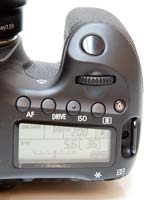 |
| Front | Top LCD Screen |
Once the EOS 60D is in the 'creative zone', users can adjust the ISO setting to one of eight positions from 100 to 12800 (you need to enable the ISO 12800 mode via the 'ISO expansion' custom function option), which is more than adequate for most lighting conditions. The EOS 60D offers a range of three Auto focus modes (One Shot, AI Focus and AI Servo), and there are six preset, auto, kelvin and custom white balance options. The viewfinder displays all key exposure information including ISO speed, and the 60D uses the same 9-point all cross-type autofocus AF system as the 50D. The 60D's metering system has been inherited from the 7D, with the 63-zone dual layer metering sensor analyzing focus, colour and luminance information to produce the exposure. There are four metering modes including a 4% Spot metering mode, useful in tricky lighting conditions as an alternative to the excellent and consistent Evaluative metering system.
The menu system is now the same in design as on the EOS 550D and 7D, which in turn borrowed the design from the professional range of EOS cameras. There's a simplified tab structure that does away completely with scrolling, with 11 colour-coded horizontal tabs (dependant upon the shooting mode) and up to 7 options in each one, providing quick and easy access to the various options. You can even setup your own customised menu page for instant access to frequently used settings via the My Menu tab. Only the complex Custom Functions menu detracts a little from the overall usability.
We tested the EOS 60D with the supplied EF-S 18-200mm f/3.5-5.6 IS lens, which offers a very versatile focal range and crucially includes image stabilisation. This is important for Canon, as competitors like Sony, Olympus and Pentax all offer image stabilisation in their DSLRs. The difference between Canon (and Nikon) and the others is that Sony, Olympus and Pentax have opted for stabilisation via the camera body, rather than the lens, which therefore works with their entire range of lenses. Canon's system is obviously limited by which lenses you choose, but it does offer the slight advantage of showing the stabilising effect through the viewfinder. Canon and Nikon also claim that a lens-based anti-shake system is inherently better too, but the jury's out on that one.
The Canon EOS 60D offers fast, positive autofocus, which can track moving subjects very well and which is also near-silent, even with the cheaper EF-S 18-200mm lens. If you're upgrading from an older or cheaper digital EOS model and already have a lens or lenses, you can buy the 60D body-only.
The EOS 60D features the same DIGIC 4 processor as its predecessor, which produces noticeably faster image processing, start-up and image review times, and better noise reduction in high-ISO images than older EOS cameras (jump to the Image Quality page for ISO samples). Due to the increase to 18 megapixels, the 60D actually shoots more slowly in the fastest Continuous mode than the previous 50D model, obtaining a speed of 5.3fps for up to 58 full-sized JPEGs or 16 RAW images (1 fps less than the 50D).
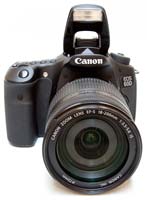 |
 |
| Pop-up Flash | Quick Menu |
Live View is much easier to actually turn on than it was on the 50D, where it was inexplicably buried away in the menu system. Now there's a dedicated Live View button on the rear of the camera to the right of the viewfinder. The new horizontal Electronic Level and very useful live histogram can be enabled to help with composition and exposure, and you can zoom in by up to 10x magnification of the image displayed on the LCD screen. Focusing is achieved either via the AF-On Lock button or more conventionally by half-pressing the shutter-button. Live View can also be controlled remotely using the supplied EOS utility software, which allows you to adjust settings and capture the image from a PC.
Live View attempts to satisfy both the consumer and more technical user, with three types of focusing system on offer. The first, Quick AF, works by physically flipping the camera mirror to engage the auto-focus sensor, which then momentarily blanks the LCD screen and causes a physical sound, before the image is displayed after about 1 second. The other methods, Live AF and Live AF with Face Detection, use an image contrast auto-focus system, much like that used by point-and shoot compacts, the main benefits being the complete lack of noise during operation, and no LCD blackout. Unfortunately these are much slower than the Quick AF mode, taking over 3 seconds to focus on a clearly-defined subject in bright light, which I think will put off most users that are attracted by the promised point-and-shoot experience. On a more positive note, you can move the AF point around the screen, and the 60D successfully detected faces in most situations.
Live View is also used for the feature that will arguably generate the most interest in the Canon EOS 60D: its movie mode. If you turn the mode dial to the position denoted by the movie camera icon, the camera will enter Live View automatically. Before you start filming, you need to focus on the subject either manually or using auto focus as described above, and optionally set exposure and ISO. To be able to do this, you first need to enter the menu, highlight "Movie exposure" on the first tab, and select "Manual". Now you can set aperture, shutter speed (within limits) and ISO manually (note that even if you do not enable manual exposure for movies, you can still use functions like AE lock and exposure compensation if you feel a need for it). Once everything is set up, you can start filming by hitting the Live View/Record button on the back of the camera.
Just like the 7d and 550D / Rebel T2i models, the EOS 60D offers a choice of 24, 25 or 30fps when recording Full HD video clips, and 50/60fps when shooting at 720p or VGA resolution. Note however that the available frame rates are also dependent on what you have set in the menu under "Video system": NTSC or PAL. Another novelty of the 60D is that if you shoot a standard-definition clip, you can use a new function called "Movie crop". This means that you can tell the camera to use only the central 640×480 pixels on the sensor to record video, which effectively gives you nearly 8x magnification. This can come in handy when you do not have the necessary telephoto reach to film something that is happening at a distance.
The EOS 60D will not automatically adjust focus during filming, but you can initiate auto focus at any time while recording a clip. However, be warned that this can do more harm than good, as the microphone can pick up the sound of the focus motor, and the subject might even go out of focus for a few seconds. Setting a small aperture and relying on depth of field for focus is a better idea. Of course you may wish to utilise the DSLR's ability to produce footage with a shallow depth of field, but in that case, it might be a wise idea to purchase a couple of third-party accessories that make manual focusing and focus pulling easier.
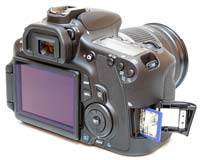 |
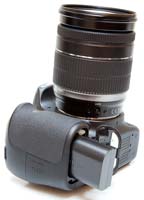 |
| Memory Card Slot | Battery Compartment |
The EOS 60D uses the same dust-removal technology as previous models, where the sensor is shaken briefly at high frequency to dislodge any dust particles from its surface. This could delay the need for manual sensor cleaning, perhaps indefinitely, but it won't be able to remove 'sticky' deposits like salt spray, pollen or the smears left behind by careless sensor cleaning or the wrong kind of solvent. The 60D also inherits the internal Dust Delete Data system from the 50D, which can map the position of visible dust on the sensor. This can then be deleted automatically after the shoot with the supplied Digital Photo Professional software.
Peripheral Illumination Correction is a feature that's actually a lot simpler that it initially sounds. Basically it corrects the unwanted effects of vignetting, typically seen in wide-angle photos in the corners of the frame. The 60D contains a database of correction data for many Canon lenses and, if Peripheral Illumination Correction is enabled, automatically applies it to JPEG images. For RAW images the correction is applied later in the Digital Photo Professional software. Up to 40 lenses can be programmed into the 60D, with over 80 currently available to choose from. Peripheral Illumination Correction is a useful and effective addition, particularly for JPEG shooters, and can safely be left turned on all of the time.
Once you have captured a photo, the Canon EOS 60D has an average range of options for playing, reviewing and managing your images. More information about a captured image can be seen on the LCD by pressing the Info button, which brings up an image histogram and all the shooting Exif data, including shutter speed and the time and date it was captured, with a second press displaying an additional RGB histogram. It is simple to get a closer look at an image as users can zoom in up to 15 times, and it is also possible to view pictures in a set of nine contact sheet. You can also delete an image, rotate an image, view a slideshow, protect images so that they cannot be deleted, and set various printing options. A rating of 1 to 5 can be assigned to your images in-camera, and these tags can also be viewed on a computer using Canon’s DPP software and some third-party image editing programs.
For RAW shooters, the EOS 60D features in-camera RAW image processing. The following adjustments can be applied to any RAW image that you have taken - Brightness, Quality, White Balance, Color Space, Picture Style, Peripheral Illumination Correction, Auto Lighting Optimizer,, Distortion Correction, High-ISO Noise Reduction, and Chromatic Aberration Correction. The image is then saved as an additional new JPEG file without affecting the original RAW data.
The documentation that comes with the 60D is very good, as it is with all Canon cameras, with a detailed manual that includes everything you need to know about the camera's operation. Unfortunately Canon have decided to cut their costs by only including it on the supplied CD-ROM, which isn't much use when you're out shooting with the camera.
No comments:
Post a Comment